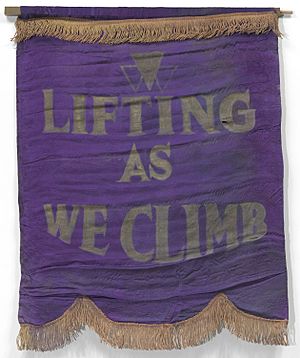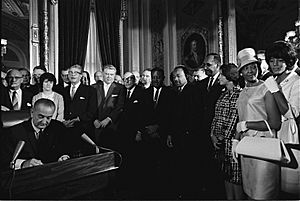Black suffrage in the United States facts for kids
The history of black suffrage in the United States is about the right of African Americans to vote in elections. This right has seen many ups and downs over time. Before the Civil War and the Reconstruction Amendments to the U.S. Constitution, some Black people could vote. However, this right was often limited or taken away. After 1870, Black people were supposed to be equal by law. But in reality, their voting rights were often blocked until the Civil Rights Act of 1964 was passed.
Contents
Early Voting Rights
When the United States was first founded, only certain people could vote. Usually, these were white men who owned land. Most Black people did not own enough property to vote. Later, rules about owning property were removed for white voters. This meant that poor white men could vote. But it also meant Black people might be able to vote too. So, new ways were found to stop them from voting.
Early laws, like the Naturalization Act of 1790, said only "free white person[s]" could become U.S. citizens. This law did not include slaves or free Black people. However, states could decide who voted in their own elections. Before the Civil War, free Black people could vote in New York, New Jersey, and Pennsylvania. But New Jersey and Pennsylvania later took away this right. New York State made it very hard for Black voters to vote by requiring them to own a lot of property.
During this time, abolitionists worked to end slavery. The call for voting rights for Black people grew stronger. In 1857, the Supreme Court's Dred Scott decision said that people of African heritage were not U.S. citizens. This decision made many people angry and was a big reason for the Civil War.
Voting Rights After the Civil War
After the Civil War, the Fifteenth Amendment to the United States Constitution was passed. This amendment said that all men, no matter their race, could vote. But in practice, Black people still faced many challenges. Some states passed "Black Codes" right after slavery ended. These laws specifically stopped Black people from voting.
The Enforcement Acts were passed to protect voters. They made it a federal crime to scare or stop people from voting. This was especially aimed at groups like the Ku Klux Klan, who used violence against Black voters.
However, after the Reconstruction Era ended, federal troops left the Southern states. This meant there was no longer strong federal protection for Black voting rights. Black people who tried to vote often faced violence and were stopped from voting. For example, the 1873 Colfax massacre happened when white locals fought Black people and federal troops over Black voting in Louisiana.
The Supreme Court also made decisions that made it harder for Black people to vote:
- In United States v. Cruikshank (1876), the Court said the federal government could only stop states from discriminating. It could not stop individuals or groups.
- In United States v. Reese (1876), the Court said voting rules like literacy tests were okay if they didn't specifically mention race. These tests often stopped Black people from voting because they were harder for them.
Jim Crow laws were also put in place in the late 1800s and early 1900s. These laws created legal racial segregation in the Southern states. They were designed to take away the voting rights and other gains Black people had made during Reconstruction.
Fighting for Voting Rights
Black people kept working to overcome these barriers. In 1905, a group of Black activists formed the Niagara Movement. They disagreed with Booker T. Washington's idea of the Atlanta Compromise. Instead, they demanded that all men should have the right to vote.
From the Niagara Movement came the National Association for the Advancement of Colored People (NAACP), formed in 1910. The NAACP worked to gain voting rights mainly through lawsuits.
- In Guinn v. United States (1915), the Supreme Court struck down a "grandfather clause". This rule allowed white people to vote even if they failed literacy tests, but it stopped Black people whose grandfathers couldn't vote.
- The Court ruled against "white primaries" (elections where only white people could vote) in Nixon v. Herndon (1927) and Nixon v. Condon (1932). After a setback in Grovey v. Townsend (1935), they were finally banned in Smith v. Allwright (1944) and Terry v. Adams (1953).
- However, in Breedlove v. Suttles (1937), the Court said that a poll tax (a fee to vote) was legal.
The Civil Rights Movement in the mid-20th century brought new focus to Black voting rights.
- In Florida, voting rights activists Harriette Moore and Harry T. Moore were killed by the KKK in 1951.
- In Gomillion v. Lightfoot (1960), the Supreme Court stopped a plan to redraw voting district lines in Tuskegee, Alabama. This plan was designed to stop Black people from voting.
- The Twenty-fourth Amendment to the United States Constitution, passed in 1962–1964, banned poll taxes for federal elections. The Supreme Court later banned state poll taxes in 1966 with Harper v. Virginia State Board of Elections.
Civil rights leaders started organized campaigns to register Black voters. One big effort was the Voter Education Project.
- In Mississippi, the fight for voting rights was very intense. This led to the death of Medgar Evers in 1963. Also, three civil rights volunteers were killed during the Freedom Summer campaign in 1964.
- Activists also created the Mississippi Freedom Democratic Party. This group challenged the white-dominated Democratic Party in Mississippi.
- In Alabama, the famous Selma to Montgomery marches in 1965 faced violence. This brought more attention to how Black voters were being stopped.
Finally, the Voting Rights Act of 1965 was passed. This important law made many unfair state voting practices illegal. The Supreme Court supported this law in 1966 with the South Carolina v. Katzenbach decision.
Modern Challenges to Voting Rights
Since the 1960s, a practice called gerrymandering has been a challenge. This is when voting district boundaries are drawn in a way that gives one group more political power. It can reduce the voting power of Black communities.
- The Supreme Court has ruled on gerrymandering many times. In Shaw v. Reno (1993), the Court said that if a redistricting plan looks "bizarre" and seems based only on race, it needs to be looked at very closely.
- The Court has stopped redistricting plans for racial gerrymandering in cases like Miller v. Johnson (1995) and Bush v. Vera (1996).
However, in 2013, the Supreme Court struck down a part of the Voting Rights Act in Shelby County v. Holder. The Court said that the racist practices that led to the law in 1965 no longer existed in 2013. After this decision, some states made it harder to vote. They closed polling places in Black neighborhoods and required official state IDs to vote. Black voters are less likely to have these IDs. While states said these rules prevented voting fraud, many believed the real goal was to reduce African-American voting.
Black Women's Suffrage Movement

Black women started working for political rights in the 1830s. Throughout the 1800s, Black women like Harriet Forten Purvis, Mary Ann Shadd Cary, and Frances Ellen Watkins Harper fought for Black civil rights, including the right to vote.
Black women had to fight for both racial equality and women's rights. They were often treated unfairly because of their race and their gender. This led them to create groups like the National Association of Colored Women's Clubs. Black women legally gained the right to vote when the Nineteenth Amendment to the United States Constitution was passed in 1920. With women gaining the vote and the Civil Rights Act, Black women became a powerful group of voters.
Even after the Nineteenth Amendment was passed, Black women were still stopped from voting. They faced violence and threats. Black women protested this in many ways. Some women, like Indiana Little, marched to their local voting offices and demanded their right to vote.


